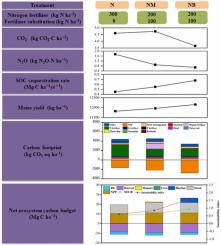当前位置:
X-MOL 学术
›
Field Crops Res.
›
论文详情
Our official English website, www.x-mol.net, welcomes your
feedback! (Note: you will need to create a separate account there.)
One–third substitution of nitrogen with cow manure or biochar greatly reduced N2O emission and carbon footprint in saline–alkali soils
Field Crops Research ( IF 5.6 ) Pub Date : 2024-07-27 , DOI: 10.1016/j.fcr.2024.109517 Sheng Zhang , Lihua Xue , Ji Liu , Pingping Jia , Ying Feng , Yi Xu , Zhijie Li , Xiaoning Zhao
Field Crops Research ( IF 5.6 ) Pub Date : 2024-07-27 , DOI: 10.1016/j.fcr.2024.109517 Sheng Zhang , Lihua Xue , Ji Liu , Pingping Jia , Ying Feng , Yi Xu , Zhijie Li , Xiaoning Zhao

|
The rapid expansion of farmland and long−term excessive nitrogen (N) application have caused huge environmental risks in fragile ecosystems facing global warming. Partially substituting N fertilizer with organic fertilizers offers an alternative field management strategy to alleviate the pressure of the ecological environment. To this end, the influence of one−third substitution of N fertilizer with cow manure or biochar field experiment was conducted under maize in Tarim River Basin since 2019. Five treatments with three replications were applied: CK (Fallow); no fertilization (0 N); conventional N fertilizer (N; N: 300 kg N ha, organic fertilizer: 0 kg N ha); one−third substitution of N with biochar (NB; N: 200 kg N ha, Biochar: 100 kg N ha) and one−third substitution of N with cow manure (NM; N: 200 kg N ha, Cow manure: 100 kg N ha) under maize season in saline−alkali soils. The greenhouse gas (GHG) emissions, net ecosystem carbon budget (NECB), soil organic carbon (SOC), maize yield, carbon footprint (CF), and yield carbon footprint (CF) were analyzed from 2021 to 2022. The results showed that NB treatment decreased the average cumulative CO emissions by 21 %, while NM treatment showed no difference compared to N treatment. NB and NM treatments reduced the average cumulative NO emissions (−61 %, −49 %), CF (−68 %, −10 %), CF (−66 %, −19 %) and increased maize yield (+3 %, +2 %), SOC storage (+43 %, +6 %), NECB (+80 %, +24 %), and agronomic N use efficiency (ANUE) (+5 %, +3 %), compared to N treatment. NB treatment had the lowest emission factors (EF) (0.19 %) and the highest sustainability index (1.58) compared to NM treatment (0.26 %, 0.61) and N treatment (0.53 %, 0.84). To sum up, substituting one−third of N fertilizer with biochar or manure in saline−alkali soils was proved to be a multi−benefit strategy to increase yields and reduce GHG emissions and CF.
中文翻译:

用牛粪或生物炭替代三分之一的氮,大大减少了盐碱土中的 N2O 排放和碳足迹
农田的快速扩张和长期过量施氮给面临全球变暖的脆弱生态系统带来了巨大的环境风险。用有机肥部分替代氮肥为缓解生态环境压力提供了一种替代田间管理策略。为此,自2019年起,在塔里木河流域玉米上进行了牛粪或生物炭替代氮肥三分之一的影响田间试验。采用5个处理,3个重复:CK(休耕);CK(休耕);没有受精(0 N);常规氮肥(N;N:300 kg N·ha,有机肥:0 kg N·ha);用生物炭替代氮的三分之一(NB;N:200 kg N ha,生物炭:100 kg N ha),用牛粪替代氮的三分之一(NM;N:200 kg N ha,牛粪:100 kg) N ha) 玉米季节盐碱地。对2021年至2022年温室气体(GHG)排放、净生态系统碳预算(NECB)、土壤有机碳(SOC)、玉米产量、碳足迹(CF)和产量碳足迹(CF)进行了分析。结果表明: NB 处理使平均累积 CO 排放量减少了 21%,而 NM 处理与 N 处理相比没有差异。 NB和NM处理减少了平均累积NO排放量(−61%,−49%),CF(−68%,−10%),CF(−66%,−19%)并增加了玉米产量(+3%,与施氮处理相比,+2 %)、SOC 存储 (+43 %、+6 %)、NECB (+80 %、+24 %) 和农艺氮肥利用效率 (ANUE) (+5 %、+3 %) 。与NM处理(0.26%,0.61)和N处理(0.53%,0.84)相比,NB处理具有最低的排放因子(EF)(0.19%)和最高的可持续性指数(1.58)。 综上所述,在盐碱土壤中用生物炭或粪肥替代三分之一的氮肥被证明是一种提高产量、减少温室气体排放和碳排放的多效益策略。
更新日期:2024-07-27
中文翻译:

用牛粪或生物炭替代三分之一的氮,大大减少了盐碱土中的 N2O 排放和碳足迹
农田的快速扩张和长期过量施氮给面临全球变暖的脆弱生态系统带来了巨大的环境风险。用有机肥部分替代氮肥为缓解生态环境压力提供了一种替代田间管理策略。为此,自2019年起,在塔里木河流域玉米上进行了牛粪或生物炭替代氮肥三分之一的影响田间试验。采用5个处理,3个重复:CK(休耕);CK(休耕);没有受精(0 N);常规氮肥(N;N:300 kg N·ha,有机肥:0 kg N·ha);用生物炭替代氮的三分之一(NB;N:200 kg N ha,生物炭:100 kg N ha),用牛粪替代氮的三分之一(NM;N:200 kg N ha,牛粪:100 kg) N ha) 玉米季节盐碱地。对2021年至2022年温室气体(GHG)排放、净生态系统碳预算(NECB)、土壤有机碳(SOC)、玉米产量、碳足迹(CF)和产量碳足迹(CF)进行了分析。结果表明: NB 处理使平均累积 CO 排放量减少了 21%,而 NM 处理与 N 处理相比没有差异。 NB和NM处理减少了平均累积NO排放量(−61%,−49%),CF(−68%,−10%),CF(−66%,−19%)并增加了玉米产量(+3%,与施氮处理相比,+2 %)、SOC 存储 (+43 %、+6 %)、NECB (+80 %、+24 %) 和农艺氮肥利用效率 (ANUE) (+5 %、+3 %) 。与NM处理(0.26%,0.61)和N处理(0.53%,0.84)相比,NB处理具有最低的排放因子(EF)(0.19%)和最高的可持续性指数(1.58)。 综上所述,在盐碱土壤中用生物炭或粪肥替代三分之一的氮肥被证明是一种提高产量、减少温室气体排放和碳排放的多效益策略。































 京公网安备 11010802027423号
京公网安备 11010802027423号